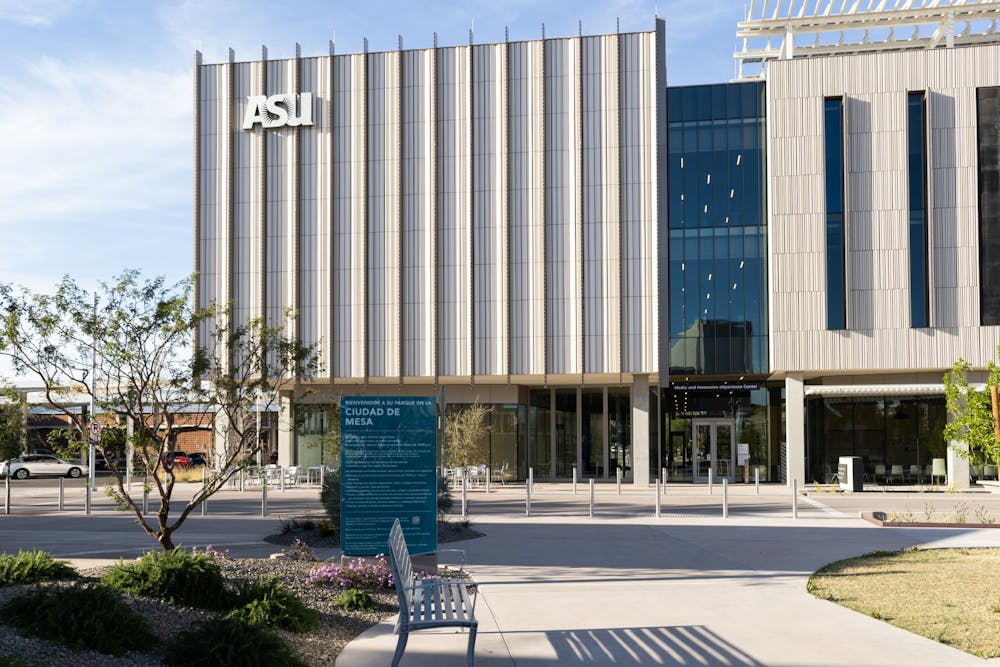The Media and Immersive eXperience Center in Mesa is home to new developments in visual media technology, with unique programs for students to pioneer in the field of media design. With a six-year construction duration, the MiX Center officially opened in Fall 2022 as a part of the Mesa City Center.
According to founding director Jacob Pinholster, the idea for a center in Mesa was conceived in 2016 during a conversation between ASU President Michael Crow and Mesa Mayor John Giles.
The infrastructure at the MiX center includes soundstages, screening rooms, color-grading studios and an enhanced immersion studio. Pinholster said these are multi-purpose facilities, and have the ability to double as classrooms for instruction.
"We wanted to build as much flexibility in the building as possible, but (it is) also for future proofing. Film still refers to itself as 'film' but the industry rarely uses it anymore," Pinholster said. "It's a sign of exactly how much change happens in that industry."
On the city's side, the motivation in wanting an ASU structure was to bring an economic center to the city, which would revitalize growth and investments.
The plan to create a building was finalized in 2017 during a meeting hosted by Pinholster, including Mesa community and city leaders, real estate developers, people from ASU and media industry experts from around the country; `all sharing the same goal of turning the initial idea into a cohesive plan.
"That one-day session generated an idea to create a building focused on media research that would be integrated with the community and (that focuses) on industry sponsored projects," Pinholster said. "That's been the mission ever since."
READ MORE: ASU hosts grand opening at Mesa City Center
The opportunities at the center have enabled industry professionals to bring their expertise and practice to the University.
Sven Ortel, a digital projection designer in the theater industry, joined the University as a professor of practice this semester. His credits include designing video and background projections for Broadway shows such as "Parade" and "Newsies".
"People from different areas with very different areas of expertise (are) coming together to educate the next generation, with a view to tackling humans' biggest problems," Ortel said. "They're just not possible in a traditional academic setting."
Ortel is working on creating a full, 3D projection space inside the Enhanced Immersion Studio, using motion capture technology and projectors.
The space will be designed with "Pixera", a software and media server that enables real-time 3D projection mapping, "TouchDesigner", a program that can map simulations of real world objects and "disguise", a platform that builds live visual experiences by connecting a physical stage with a virtual set.
"To have imagery surrounding an audience (so) that it physically envelops the people that are walking in," Ortel said. "We're definitely aiming to have it surround the audience and be about 15 feet tall. We can explore what the potential of those kinds of environments are."
Ortel is intrigued by the idea of suspending disbelief and creating fluid identities in his work, meaning he hopes people can play with the way they represent themselves inside of the simulated environments. If the line of reality is successfully blurred, the idea is that even something like gender can be dynamic.
"I've been really interested in the subject of identity and the fluidity of identity ... and hybridity like characters in a virtual world," Ortel said.
The MiX center has media infrastructure that supports running software and programs with high processing engines such as "Unreal" and "Unity", both of which are popularly used to run video game graphics.
The infrastructure, which also includes a soon-to-be Dolby-Certified screening room to be used for post-production purposes, has led to the establishment of three concentrations in the Herberger Institute for Design and the Arts: extended reality technologies, immersive experience design and futures and design, which is offered along with the College of Global Futures.
"(Extended reality design) is very popular, with software developers and people who are interested in developing work for machine learning, computer vision and artificial intelligence," said Pinholster. "(It) sits at the intersection of arts, technology and engineering."
Mary Kenny, a graduate student studying interdisciplinary digital media for performance, interned with Ortel on "Parade," designing video projections by digitally restoring real photographs dating back to the 1920s.
The same graduate program Kenny is part of incorporates a wide variety of fields, with students working on virtual reality technology and video elements that change with live music, including students working on designing headsets for pass-through augmented reality.
"The MiX center is a huge part of why I came to ASU," said Kenny. "They have this very cool major that's pretty unique to this place."
Edited by River Graziano, Piper Hansen and Grace Copperthite.
Reach the reporter at ssswamin@asu.edu and follow @shriiiitt on Twitter.
Like The State Press on Facebook and follow @statepress on Twitter.




